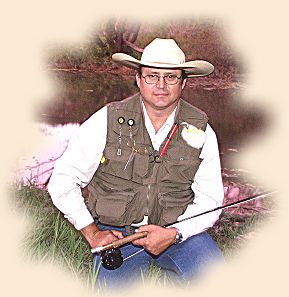Made my first trip to the San Gabriel River, North Fork, since
winter and had a new fly to try. Much of this particular area
of the San Gabriel will not get any deeper than my waist and
most of the time only about two feet. However there is the
occasional deep hole to be aware of.
The San Gabriel is an interesting river; there are stretches
where all you ever catch are panfish, large colorful panfish.
You will find everything from the bluegill, sunperch and crappie.
On other stretches it's primarily bass, big ole ornery Texas
Blackbass. Still in other areas panfish and bass share the
same holes and you never know what you will be pulling out!
The river is spring fed and in some areas the bluffs simply
pour out water.
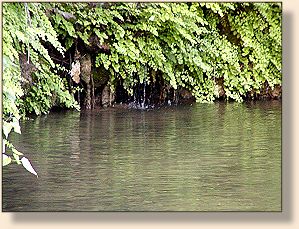
The San Gabriel has many accesses with beautiful holes to fish.
The limestone canyons provide quite solitude and on windy days,
shelter, giving the ability to fly fish. There are many places
where the river is so narrow, a mere 5 feet, that the trees
cover the waters to within a couple of feet. It's next to
impossible to fish, but these holes hold some really large
panfish.
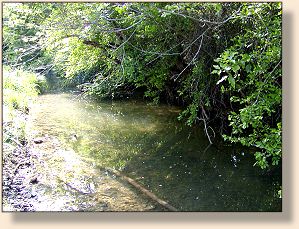
The best way I have found to fish these stretches is to get
up river, kneel in the water and pay out fly line a little
at a time allowing the fly to drift down with the current.
The panfish just can't resist! These particular holes usually
hold only a few large ones and soon become wise and will no
longer play. Time to move on.
One of my favorite entry points immediately places me in a nice
pool where the opposite bank is a tall limestone cliff with a
large fallen chunk of limestone causing the river to form a
sharp bend with a large deep pool. Casting is easy with lots
of room and the panfish, carp and bass will readily take a fly.
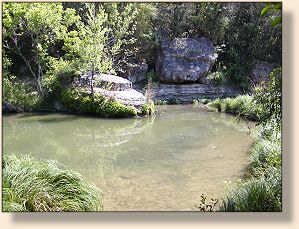
It is here that I can practice many variations in fly fishing.
I'll put out a dry fly and have the panfish and bass repeatedly
strike until they grew accustomed to it. Then when I switch to
brassies with a strike indicator the panfish once again repeatedly
strike. Using a strike indicator with a brassie will get the brassie
below the smaller fish and suspend the it near the bottom where
the larger panfish tend to be.
The wide glassy pools formed below riffles are my favorites to fish.
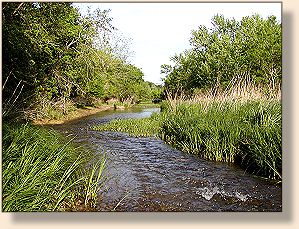
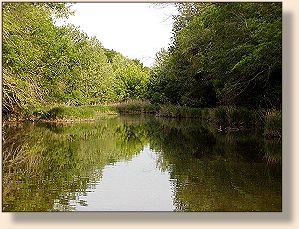
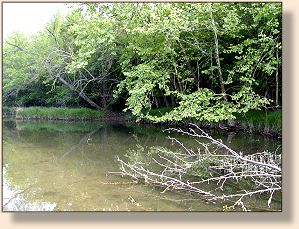
It's these pools where I have caught and released some large panfish.
With the San Gabriel Fly I was getting so many strikes that for a
while it was a fish caught for every cast! It was an incredible
afternoon! The San Gabriel Fly is very versatile. It ties really
fast and for streamside tying I highly recommend having dubbing
brushes pre-made. Variations are quick and super easy however
they do seem to perform better and get better results without
rubber legs. Any size hook can be used, color combination is
only limited by the imagination. This is not a terrestrial,
streamer or nymph. It is a pure attractor that can fished
surface, streamer or nymph. The width of the foam will determine
the buoyancy of the fly. For the San Gabriel River I have them
trimmed to just hang on the surface. Any strike from panfish will
cause it to slowly return to the surface instead of the "bounce"
as some dries tend to do. I have found the slow surfacing trait
gets more hook ups than some of the more buoyant flies.
Here are the tying instructions:
San Gabriel
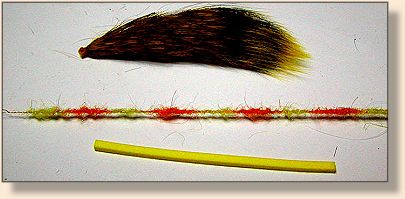
Materials:
Thread: Yellow Orvis "G".
Hook: Any size can be used but for the San
Gabriel River I use ORVIS 11HL size 12.
Body Yellow and Orange ORVIS Life Cycle Caddis
Assortment, Fine Copper Wire, Yellow 2mm Closed Cell Foam in 1/8th
inch-wide Stripes.
Tail Yellow and Black Calves Tail.
Tying Steps:
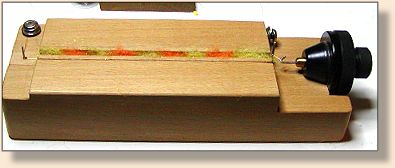
1. Create the dubbing brush, in this photo I use a dubbing block.
Yellow and Orange in alternating ¼ inch sections.
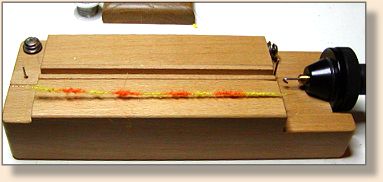 2. Lay a bead of thread, tie in the tail and leave the thread
about 2mm distance from the eye.
2. Lay a bead of thread, tie in the tail and leave the thread
about 2mm distance from the eye.
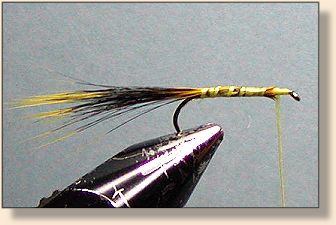
3. Tie in the dubbing brush and on top of the dubbing brush
tie in the foam strip. Leave enough foam to pinch up forming a
head just over the eye.
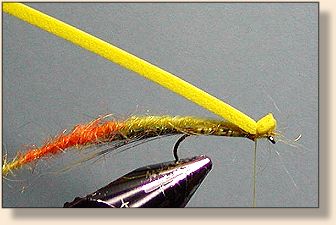
4. Keeping the dubbing brush and foam up out of the way, wrap
the thread back to the beginning of the bend of the hook.
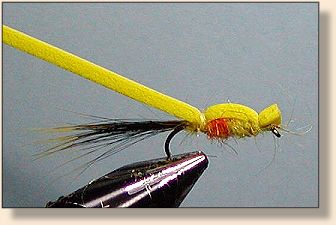
5. Wrap the dubbing back to the thread and tie in. Clip off
extra dubbing. Lay the foam over the dubbing and tie in at the
same place the dubbing was tied in. Whip finish.
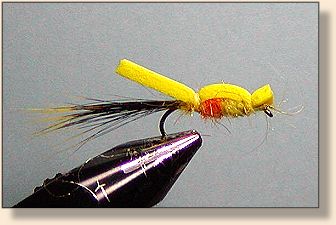
6. Trim Foam to form secondary tail. This should be about half
the length of the hair tail.
Fly is finished, go get those panfish! ~ HillFisher
|

